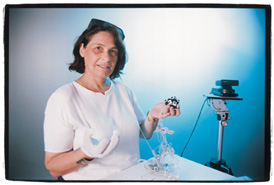Are you a journalist? Please sign up here for our press releases
Subscribe to our monthly newsletter:

Prof. Tamar Flash's scientific career demonstrates that no field of study has to be compartmentalized. At her laboratory in the Weizmann Institute's Computer Science and Applied Mathematics Department, she is applying mathematical tools to study the control of motion by the brain and in robotic systems.
Flash's interest in such seemingly disparate disciplines dates back to grade school. It should come as no surprise that her first encounter with the Weizmann Institute was in the framework of a joint meeting between a youth arts program she was attending and the Institute's youth science program.
After completing high school in Ramat Gan (in the center of Israel), Flash studied mathematics and physics at Tel Aviv University. She continued there for a master's degree in medical physics. "I wanted to study something that was more related to real life than pure, theoretical physics," she explains.
During her graduate studies, Flash carried out research on blood flow in the brain by using physics-based methods. "At some point, I 'discovered' the topic of brain research, and found it fascinating. But it took some time and experience, even trial and error, until I found the topic closest to my heart."
When Flash first decided to pursue her interest in the theoretical aspects of brain research, relatively few physicists and mathematicians were interested in the topic. "They just couldn't understand why I, with my physics and mathematics background, wanted to study the brain," she says.
Flash decided to move to MIT for her doctoral degree. In 1985, she received a Ph.D. in medical engineering and medical physics from the Division of Health Science and Technology, a unique joint program run by MIT and Harvard University. After completing her postdoctoral work at MIT, Flash joined the Weizmann Institute's Applied Mathematics and Computer Science Department. "The Institute had just set up a group to conduct artificial intelligence research, a topic that is closely related to my own interest in robotics and brain research," she says.
Flash and her colleagues study possible analogies between the control of motion in robots and in the human brain. Using physical and mathematical models, she illustrates the organizational principles that underlie biological motor control.
"In our research, we combine theoretical and experimental approaches, seeking to understand how our brain solves the complicated problems associated with controlling motor behavior. This approach can also help us to understand control in artificial, robotic systems and to develop a robotic system that behaves more intelligently."
Flash explains that this combined approach is also important in investigating debilitating diseases. "Using this approach, we can better comprehend the pathologies behind movement disorders associated with neurological diseases such as Parkinson's disease. But the only way to achieve these goals," she adds, "is through multidisciplinary collaboration."